
Late-nineteenth-century view from a stereoscope card of the Baltimore Basin (present-day Inner Harbor) looking north from historic Federal Hill toward the city’s commercial center.
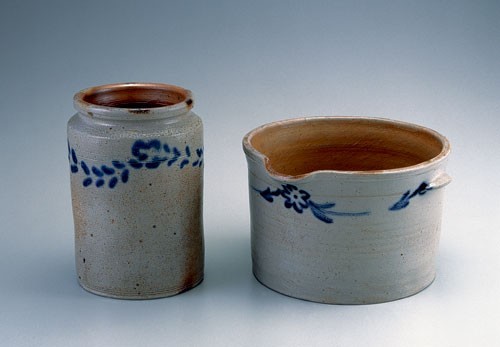
Jar and milk pan, Baltimore, ca. 1819–1825. Salt-glazed stoneware. Left: H. 8 1/4". Likely made 1819–1825 by William H. Morgan when he was associated with Morgan and Amoss, or later, during “Morgan Maker” period. Right: H. 6". Incised in freehand on bottom: “Made by Morgan & Amoss Pitt Street Baltimore 1822” (see detail, fig. 3). (Unless otherwise noted, all objects are from the author’s collection; unless otherwise noted, all photos are by Gavin Ashworth.)
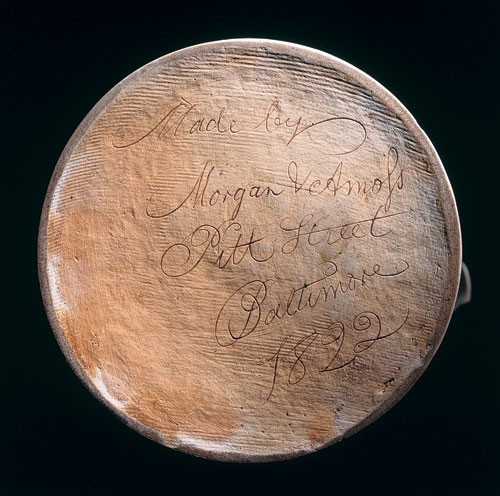
Detail of the bottom of the milk pan illustrated at right in fig. 2.

Jars, Baltimore, ca. 1819–1825. Salt-glazed stoneware. H. 9 1/2". Right: Incised, in freehand, “Pitt St. Baltimore.” These one-gallon vessels are similar in form, and their distinctive slipped floral decorations are characteristic of patterns on vessels marked “Morgan & Amoss” and “Morgan Maker.”
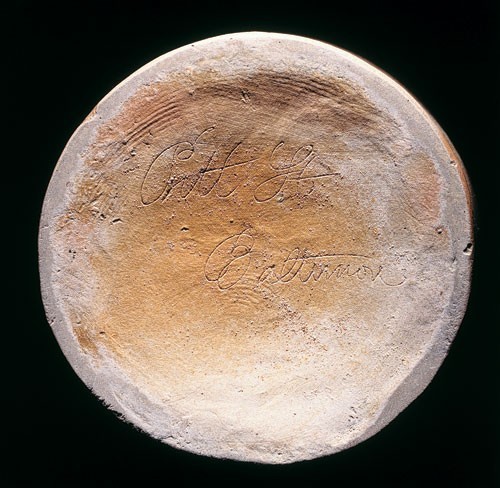
Detail of the bottom of the jar illustrated on the right in fig. 4.
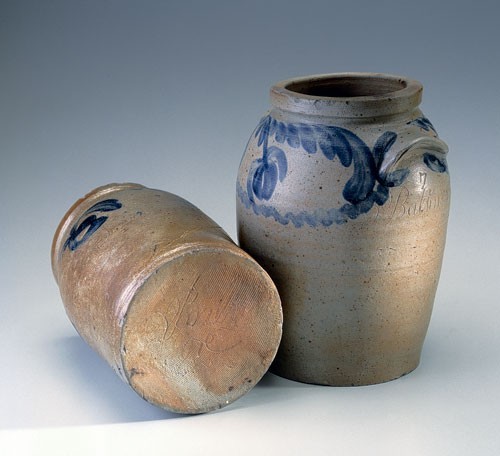
Jars, Baltimore, ca. 1830s–1840s. Salt-glazed stoneware. H. 8 1/2" and 10". The placement of the inscription “Baltimore” on these two jars highlights the random manner with which potters inscribed vessels.

Jars, Hugh R. Marshall, Baltimore, 1822. Salt-glazed stoneware. Left: H. 15 1/2". Incised in freehand on bottom: “H. R. Marshall Maker Baltimore 1822.” Right: H. 13". The jars have identical rims and similarly impressed gallon-capacity numbers outlined in cobalt decoration.
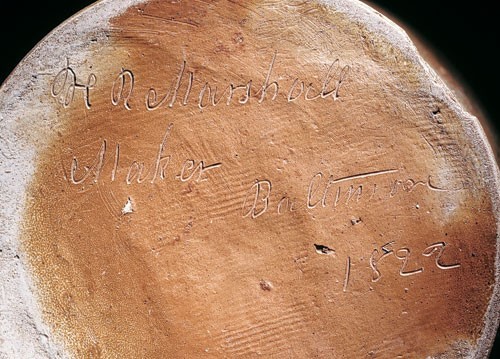
Bottom of the jar illustrated on the left in fig. 7.
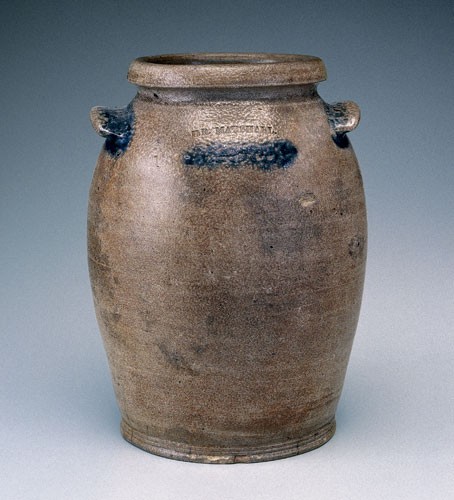
Jar, H. R. Marshall, Baltimore, probably 1820s. Salt-glazed stoneware. H. 10 1/2".
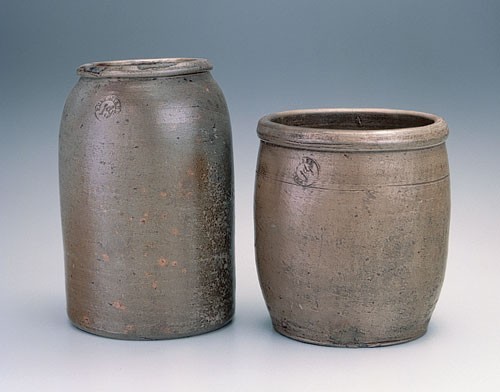
Jars, Peter Herrmann, Baltimore, ca. 1860s–1880s. Salt-glazed stoneware. H. 10 1/2" and 8 1/4". These plain one-gallon jars are marked “P. Herrmann.”

Teapot, Baltimore, 1826. Earthenware. (Courtesy, National Park Service.) This partially mended vessel was excavated at City Point, Virginia.
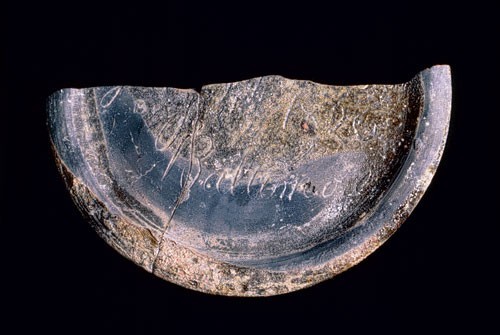
Fragment of incised base from teapot illustrated in fig. 11. (Courtesy, National Park Service.)
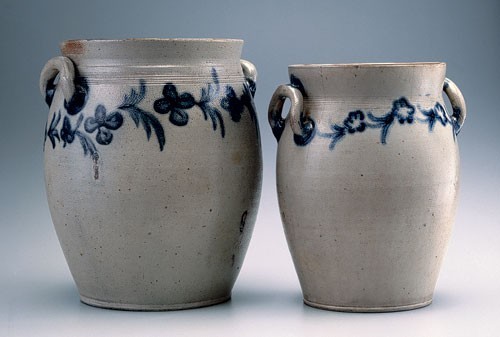
Jars, Baltimore. Salt-glazed stoneware, ca. 1819–1825. Left: H. 13 1/4". Attributed to either the Morgan and Amoss or “Morgan Maker” periods. Right: H. 12". Incised on bottom: “Morgan & Amoss Makers Pitt Street Baltimore 1821.” The jars are similar in form and share repeating floral decoration and looped or coiled handles.

Jar, Thomas Morgan Factory (Samuel Bradford), Baltimore, 1835. Salt-glazed stoneware. H. 12". Two-gallon capacity. Inscribed on bottom: “Samuel Bradford Maker at Thomas Morgan’s factory, 27 March 1835.”
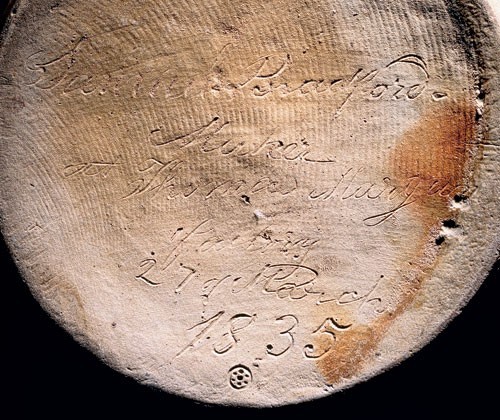
Bottom of the jar illustrated in fig. 14.
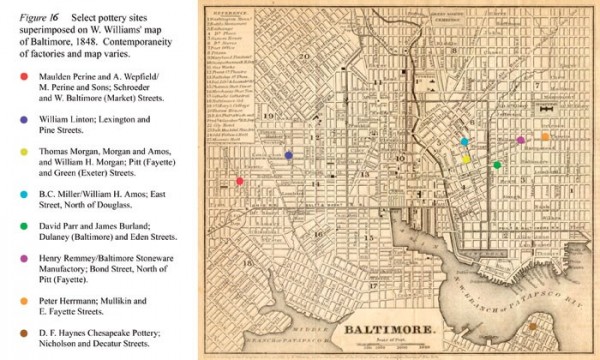
Select pottery sites superimposed on W. Williams’s map of Baltimore, 1848. The contemporaneity of the factories on the map varies..
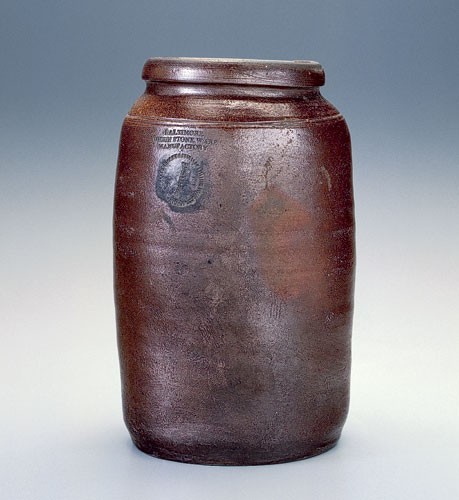
Jar, Baltimore Union Stoneware Manufactory, Baltimore, nineteenth century. Salt-glazed stoneware. H. 10 1/4". Impressed “BALTIMORE UNION STONEWARE MANUFACTORY.”
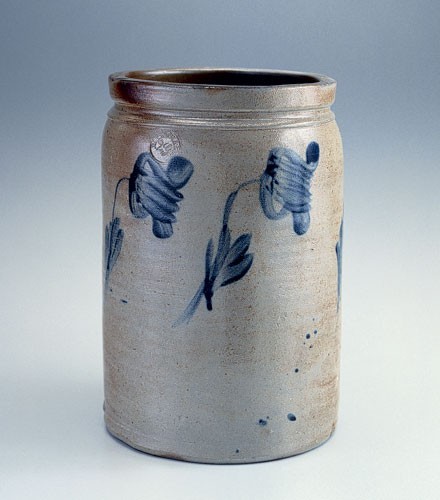
Jar, Peter Herrmann, Baltimore, 1860s–1880s. Salt-glazed stoneware. H. 12 1/2". This two-gallon jar, marked “P. Herrmann,” is decorated with unusual repeating tulips.
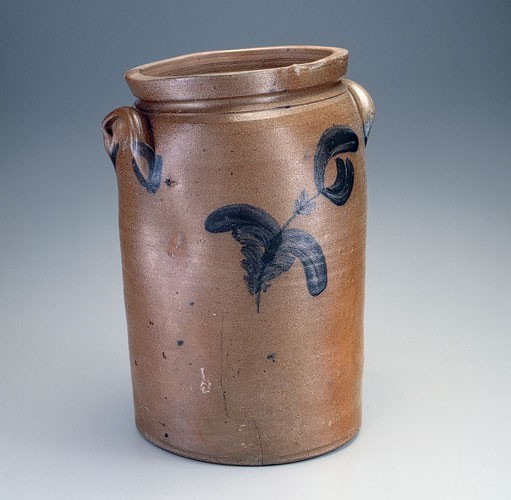
Jar, Peter Herrmann, Baltimore, ca. 1860s–1880s. Salt-glazed stoneware. H. 15". Impressed with “P. Herrmann” maker’s mark.
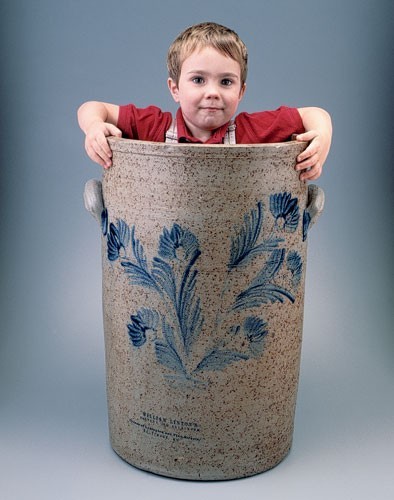
Container, William Linton, Baltimore, ca. 1849–1877. Salt-glazed stoneware. H. 24 3/4". Impressed “WILLIAM LINTON'S POTTERY AND SALESROOM Corner of Lexington and Pine Streets, BALTIMORE, MD.” A sweeping pattern of brushed flowers enhances this rare oversize vessel.
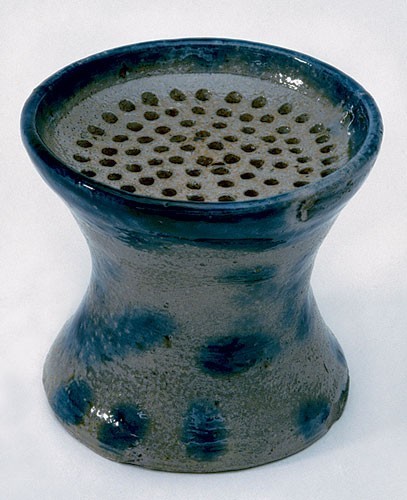
Sand caster, Benjamin C. Miller, Baltimore, 1830. Salt-glazed stoneware. H. 2 7/8". Inscribed on bottom: “B.C. Miller Maker September 1st 1830 William H. Amos.” (Courtesy, Winterthur Museum.)

Sand caster, Benjamin C. Miller, Baltimore, 1830. Salt-glazed stoneware. H. 2 7/8". Inscribed on bottom: “B.C. Miller Maker September 1st 1830 William H. Amos.” (Courtesy, Winterthur Museum.)
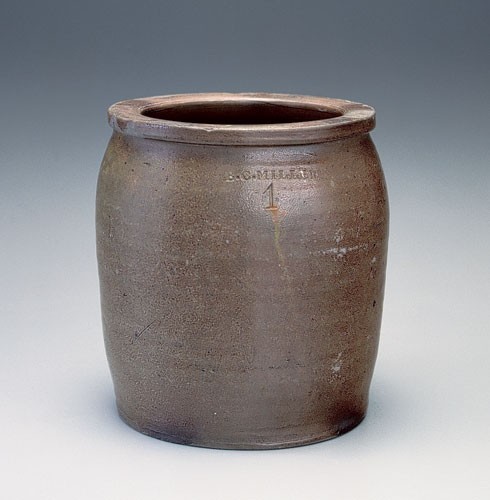
Jar, Benjamin C. Miller, probably Baltimore, ca. 1830–1833. Salt-glazed stoneware. H. 8 1/4". Impressed on the shoulder with the maker’s mark “B. C. MILLER.”
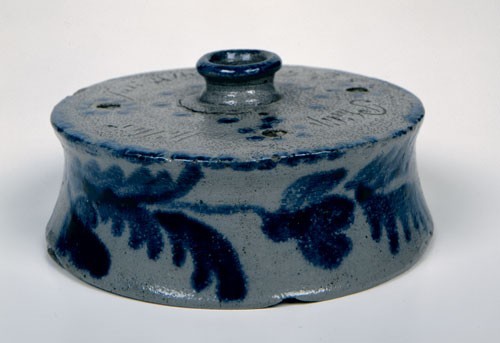
Inkwell, Phillip Miller, Baltimore, 1838. Salt-glazed stoneware. H. 2'', D. 4''. Incised on base: “P. Muller / Present fur die / Sontag Schule der 2 / Deutchen Luterishen / Kirche”; incised on top: “Phillip Miller / Juli 4th 1838.” (Courtesy, Maryland Historical Society.)

Jar, Morgan and Amoss, Baltimore, 1820. Salt-glazed stoneware. H. 14 1/2". Inscribed in freehand on bottom: “Morgan & Amoss Makers Baltimore 1820.” This rare jar is incised with two large, fanciful birds—one looking forward, the other looking behind—surrounded by graceful floral designs. The vessel has been reinforced with an old piece of copper wire placed under the rim. The decorative style and elements match those on an unsigned flowerpot previously attributed to Henry Remmey Jr. (see Zipp, Ceramics in America [2004], p. 154). The fact that both vessels show a backward-looking bird with slanted eyes standing on pointed leaves next to seven-petaled flowers and rounded flowering shoots suggests that both pieces were made by Morgan and Amoss, or perhaps both makers used the same decorator.
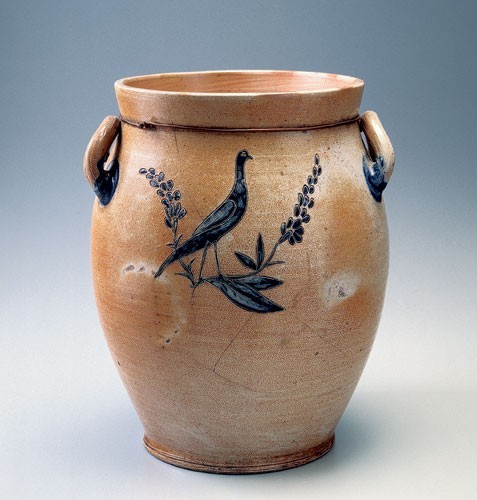
Reverse view of the jar illustrated in fig. 24.
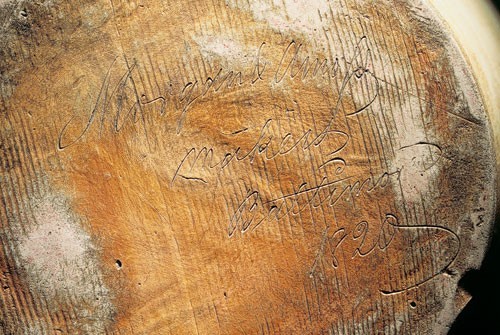
Detail of the bottom of the jar illustrated in fig. 24.

Portrait of Thomas Morgan, ca. 1830. (Courtesy, Maryland Historical Society.)
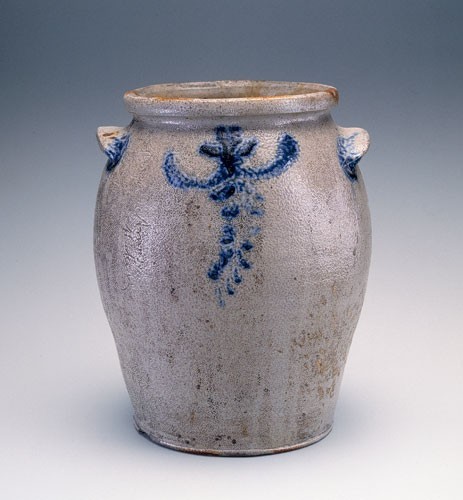
Jar, Morgan and Amoss, Baltimore, ca. 1819–1822. Salt-glazed stoneware. H. 12". Incised on one side: “Morgan & Amoss Makers.”
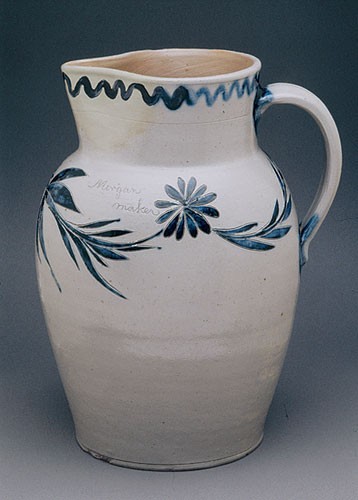
Pitcher, William H. Morgan, Baltimore, Maryland, 1823. Salt-glazed stoneware. H. 10 5/8". Inscribed on the side and bottom: “Morgan Maker Pitt Street Balto 1823.” (Courtesy, Winterthur Museum.)
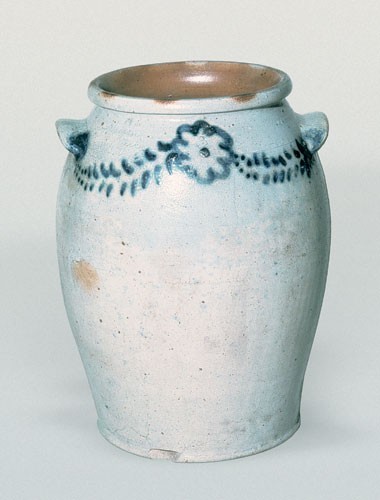
Jar, William H. Morgan, Baltimore, ca. 1823–1825. Salt-glazed stoneware. H. 13 5/8". This three-gallon jar with slipped floral decoration is incised “Morgan Maker Balto.” (Courtesy, Museum of Early Southern Decorative Arts.)
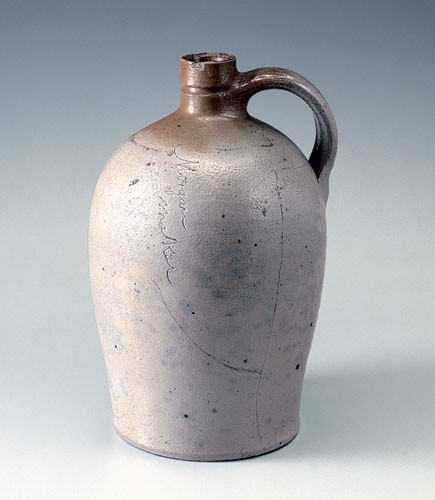
Jug, William H. Morgan, Baltimore, ca. 1823–1825. Salt-glazed stoneware. H. 8". Incised on one side: “Morgan Maker.”

Jug, William H. Morgan, Baltimore, ca. 1823–1825. Salt-glazed stoneware. H. 16". This three-gallon ovoid jug is incised “Morgan Maker” below its neck.

Jar and cooler, David Parr and James Burland, Baltimore, ca. 1815–1828. Salt-glazed stoneware. H. 7" and 16 1/2". Both vessels are impressed “PARR & BURLAND BALTIMORE.” The misalignment of the cooler’s bunghole in relation to its handles is intriguing. Was the positioning intentional or an oversight of the potter?
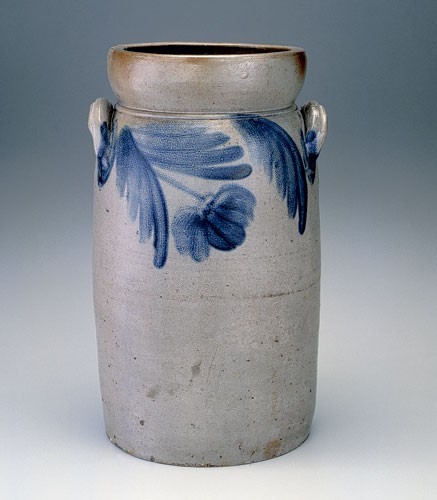
Churn, Maulden Perine, Baltimore, 1851. Salt-glazed stoneware. H. 17 1/2". This distinctive hanging flower pattern is characteristic of those found on wares made by Perine. Incised in freehand on bottom: “Baltimore Md 1851 711 Market St.” Matchett’s Baltimore Directory for 1851 (Baltimore, Md.: Printed by R. J. Matchett, 1851), p. 210, lists Maulden Perine at this address.
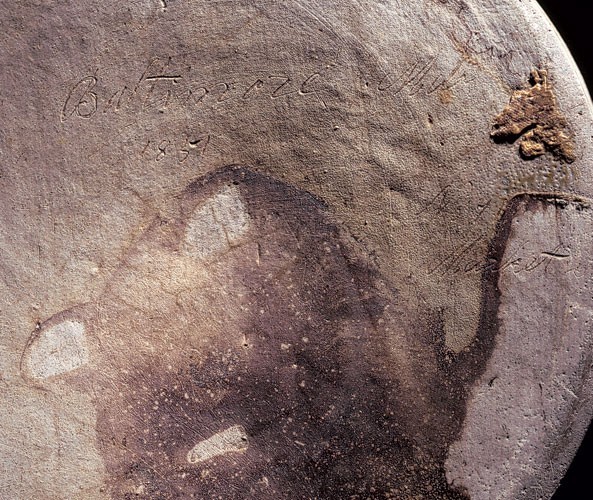
Bottom of the churn illustrated in fig. 34.

Pitcher, Henry Remmey, Baltimore, ca. 1812–1821. Salt-glazed stoneware. H. 12 1/4". Incised flowers and leaves distinguish this exceptional pitcher marked “H. REMMEY BALTIMORE.” (Courtesy, Henry Ford Museum.)
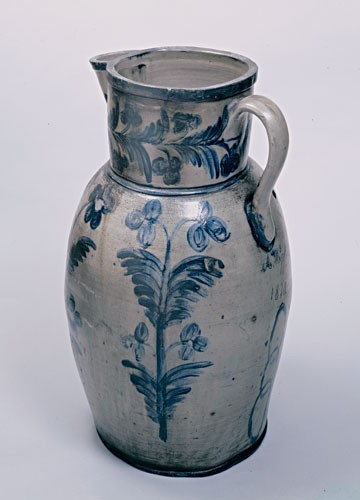
Pitcher, M. Perine and Sons (Adam Wipfield), Baltimore, 1870. Salt-glazed stoneware. H. 27". This profusely decorated oversize pitcher is dated “1870” and incised “A. Wipfield.” (Courtesy, Maryland Historical Society.)
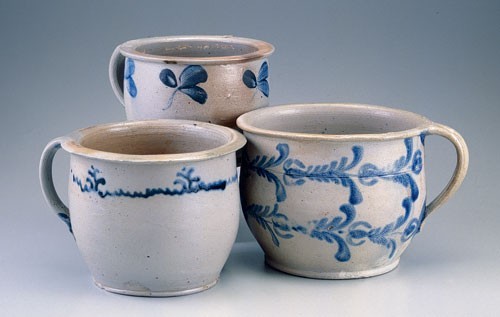
Chamber pots, probably Baltimore, ca. 1820s–1860s. Salt-glazed stoneware. H. 6 3/8", 5 5/8" (shown on pedestal), and 6 1/2". Whereas different decorative styles and techniques indicate different periods of manufacture—left, ca. 1820s; right, ca. 1830s; top, ca. 1860s—these chamber pots share the same enduring form.
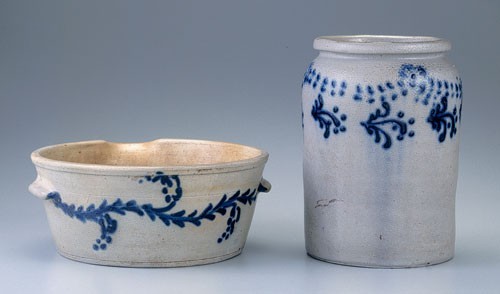
Milk pan and jar, Baltimore, ca. 1819–1825. Salt-glazed stoneware. Left: H. 3 3/4". Incised on bottom: “Pitt Street Baltimore 1824.” Right: H. 8". Both vessels are decorated with undulating and repeating slipped floral designs, motifs that are also associated with examples marked “Morgan & Amoss” and “Morgan Maker.”

Detail of the decoration on the milk pan illustrated in fig. 2, right.

Detail of the decoration on the ca. 1820s chamber pot illustrated in fig. 38.
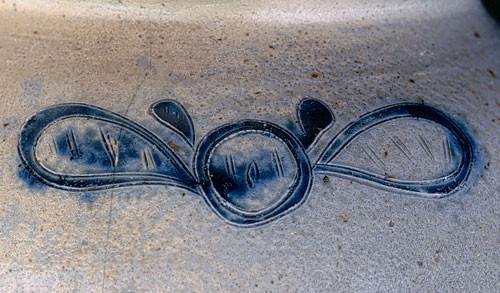
Detail of the decoration on the reverse side of the jar marked “H. R. Marshall” illustrated at left in fig. 7.
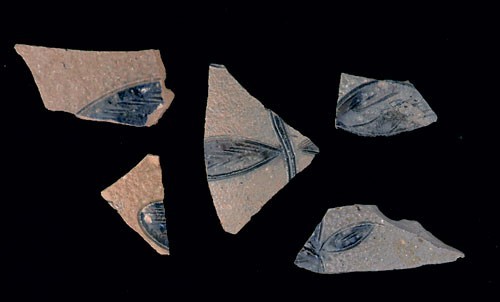
Stoneware sherds excavated at the site (18ANBC1) of the Thomas Morgan factory at Pitt and Exeter (Green) Streets in 1961 by the members of the Archeological Society of Maryland. Dr. Gregory Stiverson, director of the Historic Annapolis Foundation, discovered this archaeological collection, which was placed in storage several decades ago and subsequently forgotten.
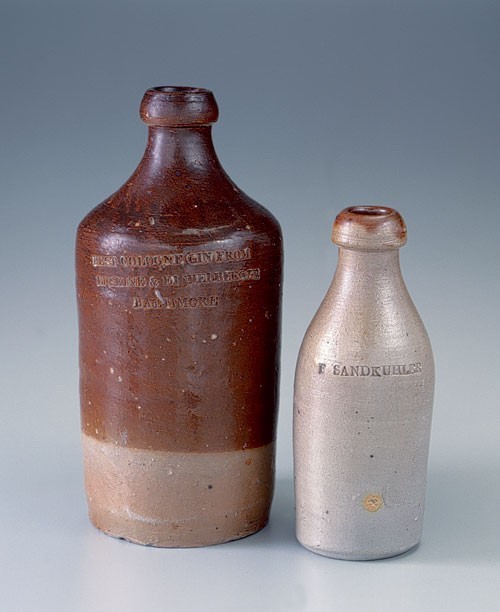
Bottles, Baltimore, ca. 1830s– 1880s. Salt-glazed stoneware. H. 8 1/2" and 6 1/2". Left: Impressed “BEST COLOGNE GIN FROM ERSKINE & EICHELBERGER BALTIMORE.” Right: Impressed “F. SANDKUHLER.”
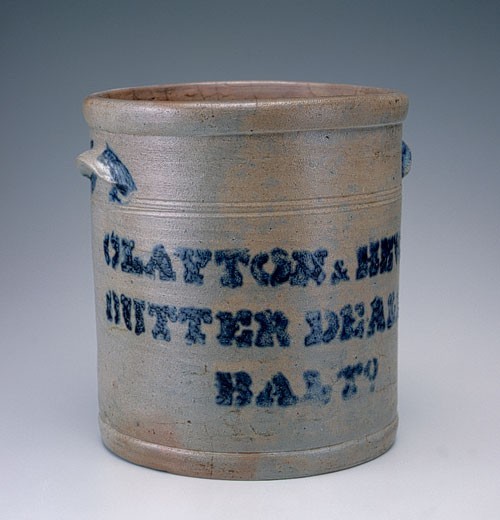
Crock, probably Baltimore, Maryland, ca. 1851. Salt-glazed stoneware. H. 11 1/2". Stenciled “Clayton & Hewes Butter Dealers Baltimore.” City directories reveal the firm of Clayton and Hewes existed in 1851, a partnership that lasted just one year. (Matchett’s Baltimore Directory for 1851, p. 56.) A similar example was made for S. Clayton and Sons Butter Packers (see fig. 59). Both vessels share similarly applied ears and brushed decoration characteristic of Baltimore manufacture.
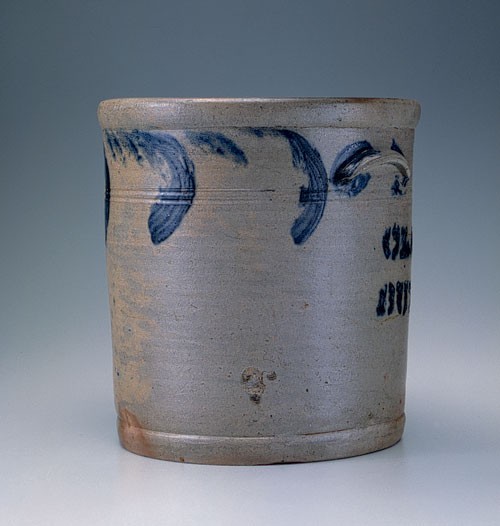
Reverse of the crock illustrated in fig. 45.

Detail of the decoration on the marked Perine churn illustrated in fig. 34.

Detail of the decoration on the jar made at the Thomas Morgan factory illustrated in fig. 14.
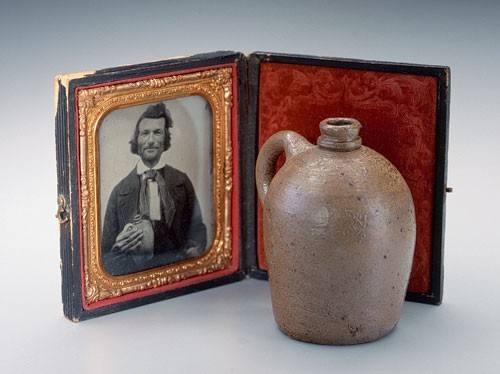
Miniature jug, probably Baltimore, mid-19th century. Salt-glazed stoneware. H. 3". Ambrotype photograph mounted in case, ca. 1855–1858.
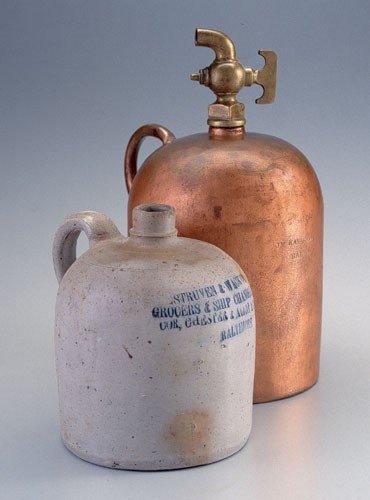
Jugs, Baltimore, ca. 1880s. Salt-glazed stoneware and copper. Back: H. 13". Impressed “JM KAVANAGH.” Front: H. 7 1/2". Impressed “STRUVEN & WACKER GROCERS & SHIP CHANDLERS COR, CHESTER & ALICE ANN ST BALTIMORE.”
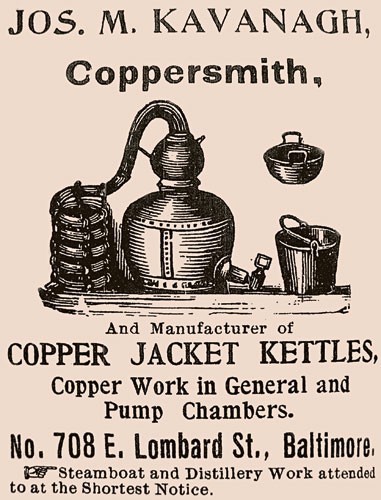
R. L. Polk and Co.’s Baltimore City Directory for 1895 advertisement for coppersmith Joseph M. Kavanagh.

Pitchers, Baltimore, ca. mid-19th century. Salt-glazed stoneware. H. 9" and 15 1/2". These pitchers are decorated with a characteristic three-petaled flower design that is associated with wares made in Baltimore.
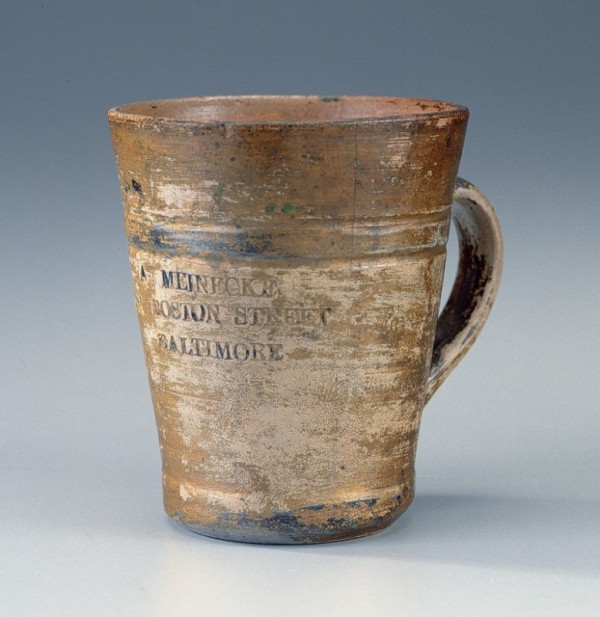
Mug, Baltimore, ca. late 1880s–early 1890s. Salt-glazed stoneware. H. 4 1/2". Impressed “A MEINECKE 2834 BOSTON STREET BALTIMORE.”

Reverse of the mug illustrated in fig. 53. Gold paint and daisies were added at a later date.
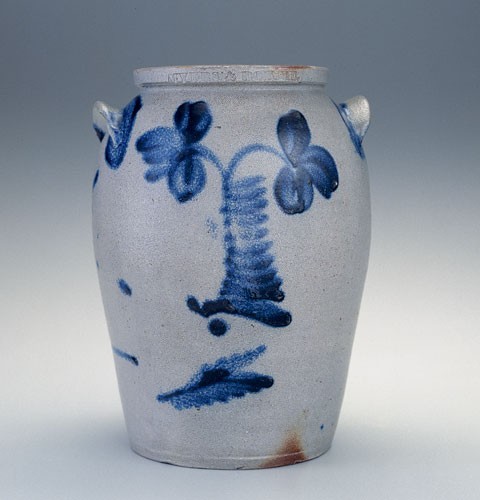
Jar, Baltimore, ca. late 1830s. Salt-glazed stoneware. H. 10". “MYERS & BOKEE” is impressed with precision on the outer rim of this one-gallon jar, an unusual location.
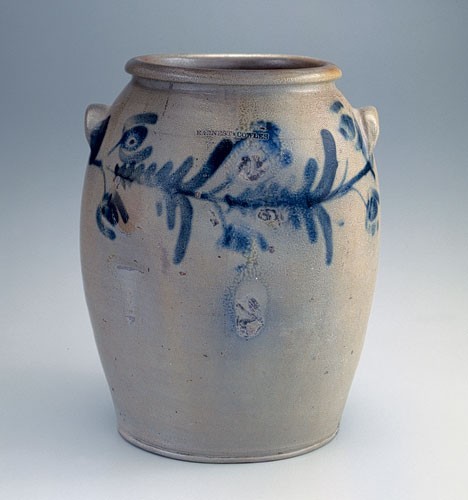
Jar, Baltimore, ca. 1830s–early 1850s. Salt-glazed stoneware. H. 13 1/2". This three-gallon jar is impressed “EARNEST & COWLES.”

Jugs, Baltimore, ca. mid-1870s–early 1880s. Salt-glazed stoneware. Left: H. 7 3/4". Impressed “CHARLES W. SIEBERT WINES & LIQUORS N.E. COR. PRATT & MARKET SPACE BALTIMORE MD.” Right: H. 7 1/2". Impressed “HAMMEL & BONEAU IMP’S’ OF WINES & LIQUORS 16 CENTRE MARKET SPACE.”

Coolers, Baltimore, ca. 1870s. Salt-glazed stoneware. Left: H. 16". Impressed “DR. B. BATES, WINE CIDER.” Right: H. 13 3/8". Impressed “MEETER & BRO.”
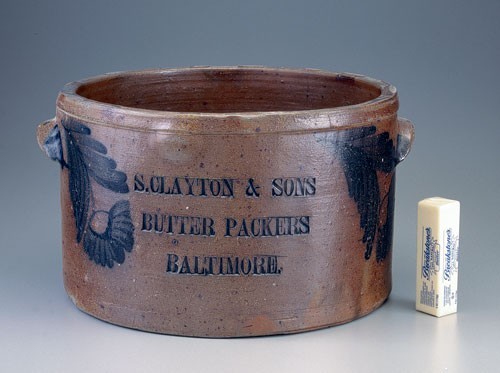
Butter crock, Baltimore, ca. 1845–1850. Salt-glazed stoneware. H. 9". Impressed “S. CLAYTON & SONS BUTTER PACKERS BALTIMORE.” The stick of butter highlights the unusually large size of the crock.

Jug, Baltimore, ca. 1870s–1880s. Salt-glazed stoneware. H. 4 1/2". Impressed “NUMSEN’S YACHT. CLUB VINEGAR.

Jar and jug, Baltimore, ca. 1870s–1880s. Salt-glazed stoneware. Left: H. 7". This jar once had a lid and is impressed “GEO. H. EDGAR SHIP CHANDLERS & GROCERS NO. 73 SMITH'S WHARF BALTIMORE.” Right: 7 1/2". Impressed “H. STEFFENS SHIP-CHANDLER 987 & 989. FELL ST BALTIMORE MD.”
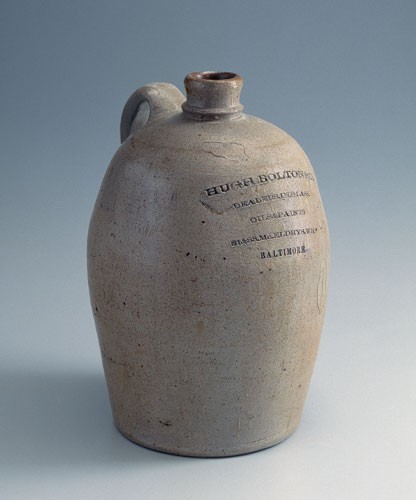
Jug, Baltimore, ca. 1870s–1880s Salt-glazed stoneware. H. 10 1/2". Impressed “HUGH BOLTON & CO. DEALERS IN GLASS, OILS & PAINTS, 81 & 83 MCELDRY’S. WHF BALTIMORE.”
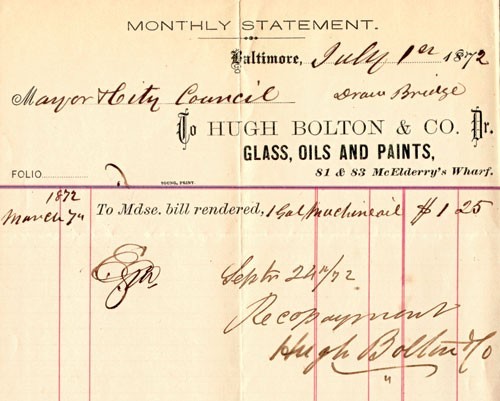
Billhead receipt from Hugh Bolton & Co., July 1, 1872.
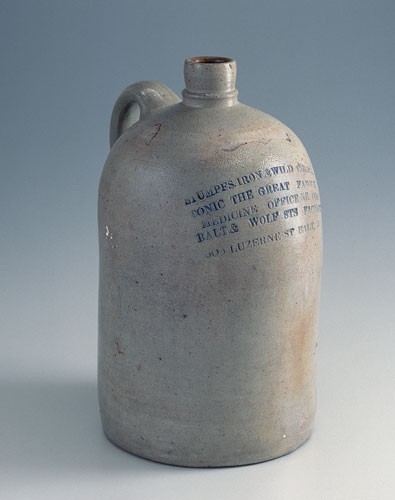
Jug, Baltimore, ca. 1870s–1880s. Salt-glazed stoneware. H. 11 1/4". Impressed “STUMPFS. IRON & WILD CHERRY TONIC THE GREAT FAMILY MEDICINE, OFFICE N.E. COR BALT, & WOLF STS FACTORY 605 LUZERNE ST BALT MD.”
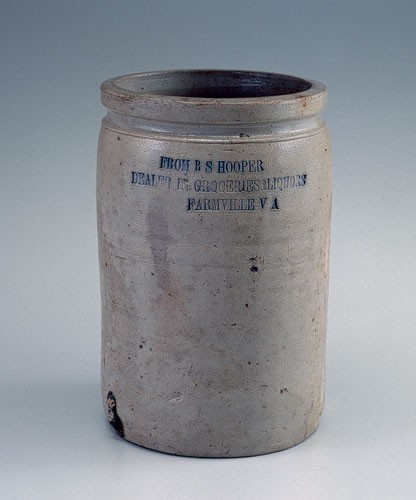
Jar, probably Baltimore, ca. 1860s–1880s. Salt-glazed stoneware. H. 10". Impressed “BS HOOPER DEALER IN GROCERIES & LIQUORS FARMVILLE VA.”

Jar, Western Pennsylvania, ca. early 1880s. Salt-glazed stoneware. H. 12". This two-gallon jar is stenciled “D. F. HAYNES AND CO. CROWN BRAND BALTIMORE M.D.”
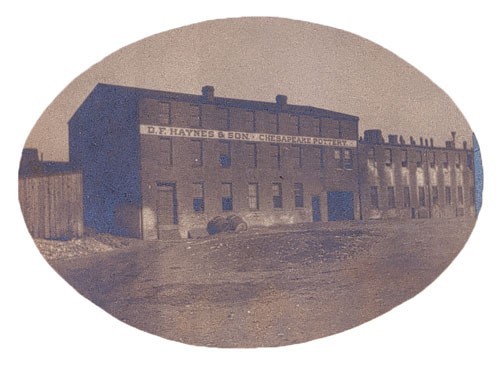
Postcard detail of D. F. Haynes & Sons Chesapeake Pottery at Nicholson and Decatur Streets, dated October 2 (20?), 1905. The handwritten inscription on the front—“A remembrance of the old place to show you that you are not forgotten. [signature illegible]”—suggests that this card was sent to a former employee at the factory.
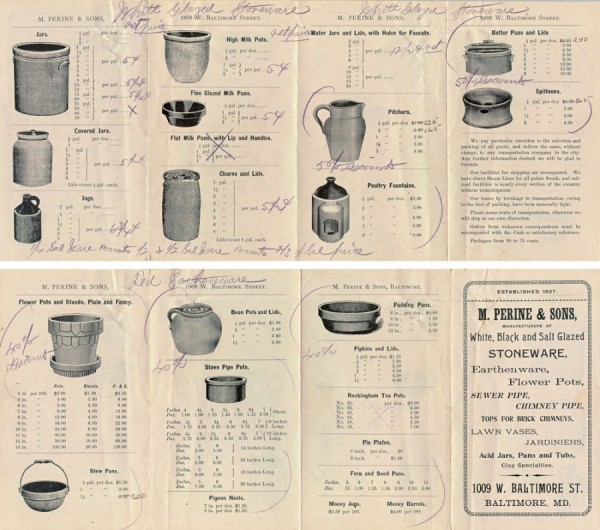
Price list, M. Perine & Sons, 1895. Top: “White Glazed Stoneware.” Bottom: “Red Earthenwares.”
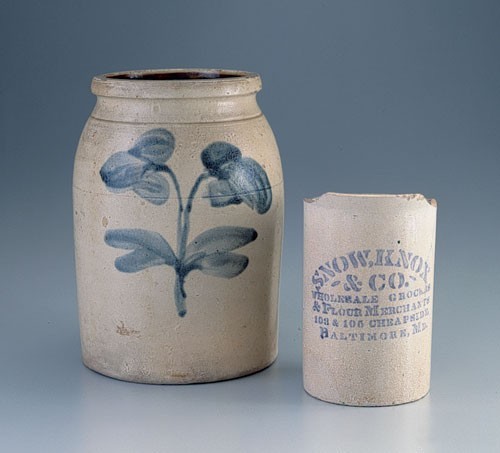
Jar and pitcher, late nineteenth century. Bristol white-glaze stoneware. Left: H. 10". A three-petal motif appears on both sides of this jar of unknown origin. Right: H. 6 1/2". Cobalt stenciling reads “SNOW, KNOX & CO. WHOLESALE GROCERS & FLOUR MERCHANTS 103 & 105 CHEAPSIDE BALTIMORE, MD.” This type of pitcher has also been seen with the impressed maker’s mark of the Burley and Winter Pottery, located in Crooksville, Ohio.

Pitcher, possibly Thomas Haig, Philadelphia, late ninetheenth century. Bristol white-glaze stoneware. H. 10".
